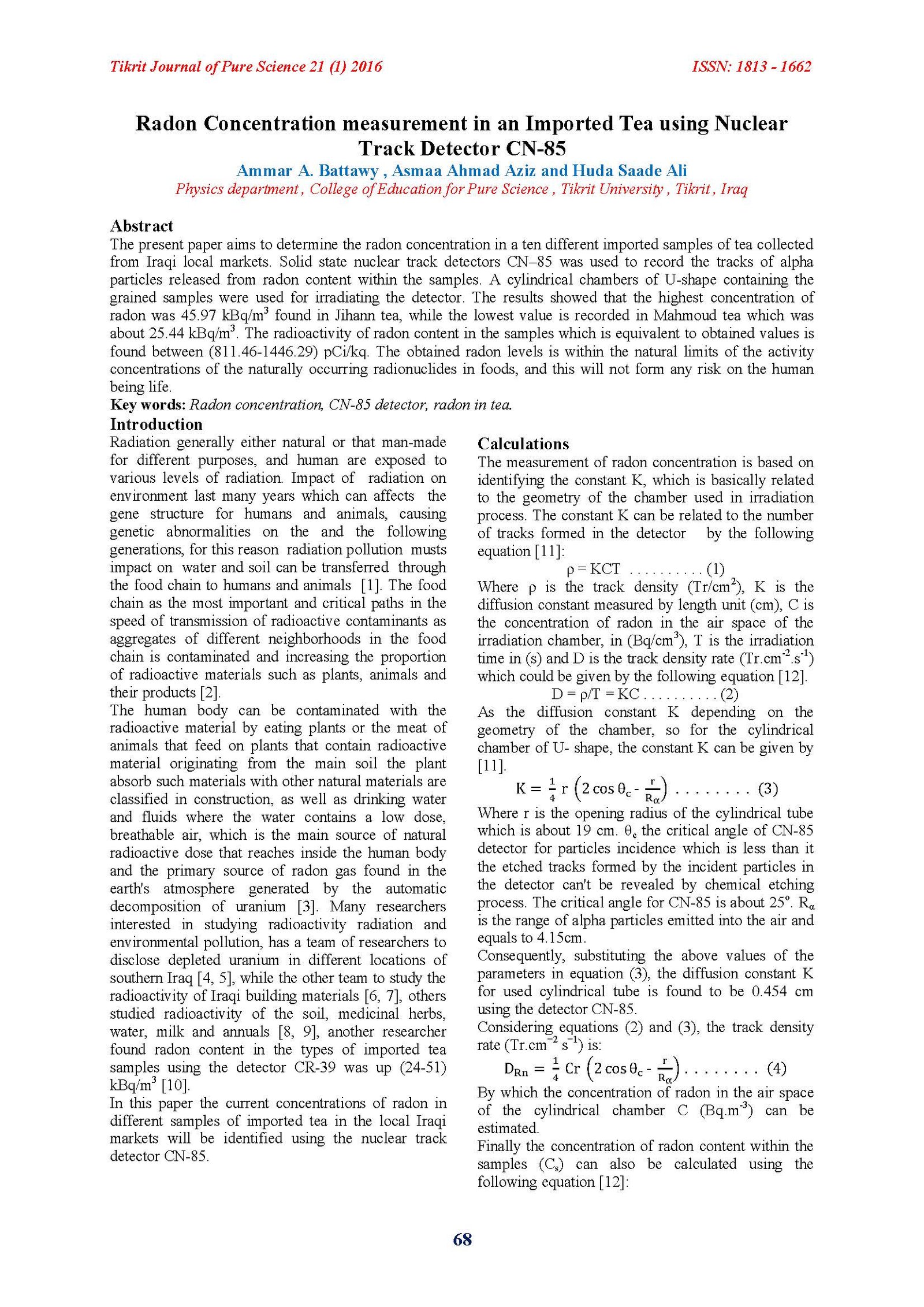Radon Concentration measurement in an Imported Tea using Nuclear Track Detector CN-85
Main Article Content
Abstract
The present paper aims to determine the radon concentration in a ten different imported samples of tea collected from Iraqi local markets. Solid state nuclear track detectors CN–85 was used to record the tracks of alpha particles released from radon content within the samples. A cylindrical chambers of U-shape containing the grained samples were used for irradiating the detector. The results showed that the highest concentration of radon was 45.97 kBq/m3 found in Jihann tea, while the lowest value is recorded in Mahmoud tea which was about 25.44 kBq/m3. The radioactivity of radon content in the samples which is equivalent to obtained values is found between (811.46-1446.29) pCi/kq. The obtained radon levels is within the natural limits of the activity concentrations of the naturally occurring radionuclides in foods, and this will not form any risk on the human being life.
Article Details

This work is licensed under a Creative Commons Attribution 4.0 International License.
Tikrit Journal of Pure Science is licensed under the Creative Commons Attribution 4.0 International License, which allows users to copy, create extracts, abstracts, and new works from the article, alter and revise the article, and make commercial use of the article (including reuse and/or resale of the article by commercial entities), provided the user gives appropriate credit (with a link to the formal publication through the relevant DOI), provides a link to the license, indicates if changes were made, and the licensor is not represented as endorsing the use made of the work. The authors hold the copyright for their published work on the Tikrit J. Pure Sci. website, while Tikrit J. Pure Sci. is responsible for appreciate citation of their work, which is released under CC-BY-4.0, enabling the unrestricted use, distribution, and reproduction of an article in any medium, provided that the original work is properly cited.
References
[1] Colmenero Sujo, L., Montero Cabrera, M. E., "Uranium-238 and thorium-232 series concentrations in soil" Journal of Environmental Radioactivity, 77 (2), 205-219, 2004
[2] Berlin, M. and Rudell, B. Uranium. In: Handbook on the toxicology of metals. 2nd edition. L. Friberg, G.F. Nordberg and V.B. Vouk (eds.). Elsevier Science Publishers, Amsterdam. 623-637, 1986
[3] IAEA International Atomic Energy Agency ,”Environment behaviors of radium technical reports”, 1 (310), 192, 1990
[4] Ukla, S Y. H., "Determination of radon, uranium and other radioactive isotopes concentration in different types of natural water in Nenava governorate", M.Sc. Thesis, Physics Department, College of Education, University of Mosul, Iraq, 2005.
[5] Al- Jubouri A. H., "Determination of the concentrations of a depleted uranium in the remnants of military equipment in certain locations from southern Iraq using HPGe detectors and CR-39", M.Sc. Thesis, Physics Department, College of Science, University of Mosul, Iraq, 2003.
[6] Khalil, M. A. and Mohammed F., "Detection of depleted uranium in soils from sites of battles or using the CR-39", Journal of the Science of Mesopotamia, 8 (2). 1997.
[7] Baroudi, H. I. H., "Using Cesium – Potassium Ratio to Determine the Environmental Radioactive Contamination Compared with Nuclear Track Detector CR-39", PhD. Thesis, Physics Department, College of Science, University of Mosul, Iraq, 2004.
[8] Al-Khafaji, K. Sh. J. , "A study of natural radioactivity contamination of building materials in the middle Euphrates region", M.Sc. Thesis, Physics Department, College of Science, University of Baghdad, Iraq, 2000.
[9] Al-Sabha, L. A., Yousif, R, M and Al-Badrani, M. M., "A study of radioactive and toxic contamination in soil from Mosul site", Rafidain Jour. Sci., 11(4), 136-140, 2000.
[10] Al-Goubory M. A., "Determination of 222Rn in different types of tea", M.Sc. Thesis, Physics Department, College of Science, Mosul University, Iraq 1999.
[11] Ahmed, M. O., "Use of nuclear contamination detector technique CR-39 for sensing contamination radioactive depleted uranium in specific areas of the province of Salahuddin", Proceedings of the First Scientific Conference of College of Science , University of Tikrit, Salahuddin, Iraq. 2009. [12] ICRP, protection against Rn-222 at home and at work, ICRP Publication 65, Annuals of ICRP 23, 1993. [13] ICRP: Consultation view comment. The draft ICRP recommendations (paragraph 209) report in the UNSCEAR 2000 report Vol.1 (Annex B: Exposure from natural radiation sources). http://www.icrp.org/consultation_viewitem.asp?guid=%7B1089DE47-4CDE-4EFA-BD26-E8BD4298F9B9%7D http://www.unscear.org/unscear/en/publications/2000_1.html
